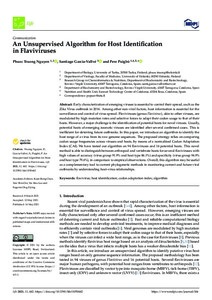An Unsupervised Algorithm for Host Identification in Flaviviruses
Truong Phuoc Nguyen; Garcia-Vallvé Santiago; Puigbò Pere
An Unsupervised Algorithm for Host Identification in Flaviviruses
Truong Phuoc Nguyen
Garcia-Vallvé Santiago
Puigbò Pere
MDPI
Julkaisun pysyvä osoite on:
https://urn.fi/URN:NBN:fi-fe2021093049013
https://urn.fi/URN:NBN:fi-fe2021093049013
Tiivistelmä
Early characterization of emerging viruses is essential to control their spread, such as the Zika Virus outbreak in 2014. Among other non-viral factors, host information is essential for the surveillance and control of virus spread. Flaviviruses (genus Flavivirus), akin to other viruses, are modulated by high mutation rates and selective forces to adapt their codon usage to that of their hosts. However, a major challenge is the identification of potential hosts for novel viruses. Usually, potential hosts of emerging zoonotic viruses are identified after several confirmed cases. This is inefficient for deterring future outbreaks. In this paper, we introduce an algorithm to identify the host range of a virus from its raw genome sequences. The proposed strategy relies on comparing codon usage frequencies across viruses and hosts, by means of a normalized Codon Adaptation Index (CAI). We have tested our algorithm on 94 flaviviruses and 16 potential hosts. This novel method is able to distinguish between arthropod and vertebrate hosts for several flaviviruses with high values of accuracy (virus group 91.9% and host type 86.1%) and specificity (virus group 94.9% and host type 79.6%), in comparison to empirical observations. Overall, this algorithm may be useful as a complementary tool to current phylogenetic methods in monitoring current and future viral outbreaks by understanding host-virus relationships.
Kokoelmat
- Rinnakkaistallenteet [27094]
